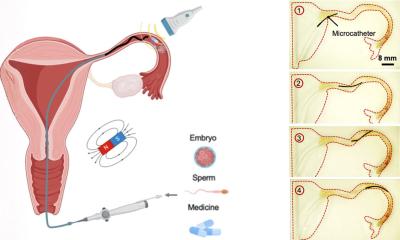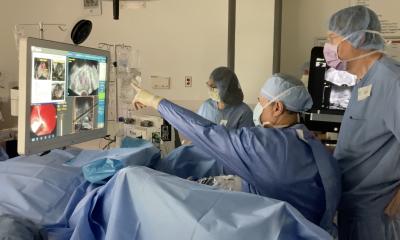Heart Rhythm Disorders: Better outcome with catheter ablation
According to data appeared on January, 26th, 2010 in JAMA (Journal of American Medical Association), patients with a common heart rhythm disorder, called Atrial Fibrillation, who were treated with catheter ablation* demonstrated significantly better outcomes at one year compared to those receiving drug therapy. In addition, the patients treated with catheter ablation reported markedly fewer symptoms and substantially improved quality of life.
Atrial fibrillation, or AFib as it is more commonly referred to, is the most prevalent heart rhythm disorder, affecting an estimated 20 million people worldwide. It is also one of the most common causes of stroke among people 65 years and older.
During cardiac ablation, a catheter is inserted into the heart and energy is delivered through the catheter to those areas of the heart muscle causing the abnormal heart rhythm. This energy “disconnects” the pathway of the abnormal rhythm.
At one year, 66% of patients treated with catheter ablation remained free from documented symptomatic AFib, compared to 16% of patients treated with medical therapy, also commonly referred to as anti-arrhythmic drugs or AADs (95% CI: 0.19, 0.47; P < .001). In addition, quality of life scores improved significantly in patients treated with ablation at three months, and this improvement was maintained at one year. According to this study, ablation treatment, which restores and maintains normal sinus rhythm, was associated with improved quality of life.
“Though anti-arrhythmic drugs are generally used as first-line therapy to treat AFib, a number of clinical trials, including this one, have demonstrated that their effectiveness remains inconsistent,” said David Wilber, M.D., Primary Investigator and Lead Author of the study and the George M. Eisenberg Professor of Cardiovascular Sciences and Director, Division of Cardiology, Loyola University Medical Center in Maywood, Illinois. “The likelihood of AFib recurrence within 6-12 months approaches 50% with most drugs, and AADs are also associated with cumulative adverse effects over time.”
This clinical trial was a randomized, controlled trial of symptomatic, paroxysmal AFib patients whose symptoms were not controlled on at least one AAD and had at least three episodes of AFib in the six months prior to joining the trial. A total of 167 patients were enrolled from 19 sites throughout the world. The primary effectiveness endpoint was freedom from documented symptomatic AFib recurrence following the confirmation of the ablation procedure endpoint and absent new AAD use or a repeat ablation procedure outside of protocol-defined criteria.
The NAVISTAR® THERMOCOOL® Catheter ablation group also demonstrated an excellent safety profile with no device-related serious adverse events such as death, heart attack, stroke, cerebrovascular accident, heart block or atrial perforation within seven days post ablation. Importantly, the incidence of treatment related adverse events measured at 30 days in the THERMOCOOL® Catheter ablation group was observed to be approximately half that in the AAD group (5% vs. 9%) and there was no clinically significant pulmonary vein stenosis in patients receiving ablation.
“This prospective, multi-center, randomized study confirms, finally, what electrophysiologists have been saying and demonstrating for years: atrial fibrillation can be treated with radiofrequency catheter ablation”, said Prof. Carlo Pappone, currently Director of the Arrhythmology Department, Villa Maria Cecilia Hospital in Cotignola (Ravenna, Italy).”
“In addition to improving the quality of patients’ life, this technique avoids the side effects of a long-term drug therapy”, said Dr. Pappone. “Thus, hopefully this work will remain a fundamental reference in scientific research, in order to defeat atrial fibrillation.”
AFib: Growing Statistics and Current Treatment Options
AFib is the most prevalent heart rhythm disorder, yet fewer than 110,000 patients per year are treated worldwide with ablation. Most patients with AFib today are treated with AADs even though in about half of them, the drugs do not control the AFib symptoms.
“The results of this study provide important information for patients with AFib and their physicians because AFib represents an important public health problem, including an increased long-term risk of stroke, heart failure, and all cause mortality,” said Dr. Wilber.
In 2006, the leading medical societies including the American Heart Association, American College of Cardiology and the European Society of Cardiology recommended catheter ablation as second-line therapy for AFib.
In addition to his role as Primary Investigator, Dr. Wilber is compensated for his services as a member of the Company’s scientific advisory board and provides other consulting services. Prof. Carlo Pappone is also a member of the Company’s scientific advisory board and a paid consultant of Biosense Webster.
*NAVISTAR® THERMOCOOL® Catheter: The NAVISTAR® THERMOCOOL® Catheter, manufactured by Biosense Webster, Inc. is the only ablation catheter approved by the U.S. Food and Drug Administration for the treatment of drug refractory recurrent symptomatic paroxysmal AFib when used with CARTO® Navigation Systems. The NAVISTAR® THERMOCOOL® Catheter is also CE marked and commercially available in Europe.
29.01.2010











